Abstract
Continuous meshless approximations are developed for domains with non-convex boundaries, with emphasis on cracks. Two techniques are developed in the context of the element-free Galerkin method: a transparency method wherein smooth approximations are generated by making boundaries partially transparent, and a diffraction method, where the domain of influence wraps around a concave boundary. They are compared to the original method based on the visibility criterion in which the approximations are discontinuous in the vicinity of nonconvex boundaries. The performance of the methods is compared using two elastostatic examples: an infinite plate with a hole and a crack problem. The continuous approximations show only moderate imporvement in accuracy over the discontinous approximations, but yield significant improvements for enhanced bases, such as crack-tip singular functions.
Similar content being viewed by others
References
Anderson, T. L. 1991: Fracture Mechanics: Fundamental and Applications (First ed.). CRC Press
Atluri, S. N.; Kobayashi, A. S.; Nakagaki, M. 1975: An assumed displacement hybrid finite element model for linear fracture mechanics. International Journal of Fracture 11 (2): 257–271
Babuska, I.; Melenk, J. M. (in preparation). The partition of unity finite element method
Belytschko, T.; Krongauz, Y.; Fleming, M.; Organ, D.; Liu, W. K. (to appear). Smoothing and accelerated computations in the element-free Galerkin method. Journal of Computational and Applied Mathematics
Belytschko, T.; Lu, Y. Y.; Gu, L. 1994: Element-free Galerkin methods. International Journal for Numerical Methods in Engineering 37, 229–256
Belytschko, T.; Lu, Y. Y.; Gu, L.; Tabbara, M. 1995: Element-free Galerkin methods for static and dynamic fracture. International Journal of Solids and Structures 32 (17), 2547–2570
Benzley, S. E. 1974: Representation of singularities with isoparametric finite elements. International Journal for Numerical Methods in Engineering 8: 537–545
Duarte, C. A.; Oden, J. T. 1995: Hp clouds — a meshless method to solve boundary-value problems. Technical Report 95-05, Texas Institute for Computational and Applied Mathematics, University of Texas at Austin
Fleming, M.; Chu, Y. A.; Moran, B.; Belytschko, T. (submitted): Enriched element-free Galerkin methods for singular fields. International Journal for Numerical Methods in Engineering
Hegen, D. 1994: Numerical techniques for the simulation of crack growth. Technical report, Eindhoven University of Technology. Final report of the postgraduate programme Mathematics for Industry
Krysl, P.; Belytschko, T. (submitted): Nonconforming element-free Galerkin method. Computer Methods in Applied Mechanics and Engineering
Lancaster, P.; Salkauskas, K. 1981: Surfaces generated by moving least squares methods. Mathematics of Computation 37: 141–158
Liu, W. K.; Jun, S.; Li, S.; Adee, J.; Belytschko, T. 1995: Reproducing kernel particle methods for structural dynamics. International Journal for Numerical Methods in Engineering 38, 1655–1679
Liu, W. K.; Li, S.; Belytschko, T. (submitted): Moving least square kernel method, methodology and convergence. Computer Methods in Applied Mechanics and Engineering
Moran, B.; Shih, C. F. 1987: Crack tip and associated domain integrals from momentum and energy balance. Engineering Fracture Mechanics 27(6): 615–641
Nayroles, B.; Touzot, G.; Villon, P. 1992: Generalizing the finite element method: diffuse approximation and diffuse elements. Computational Mechanics 10: 307–318
Nikishkov, G. P.; Atluri, S. N. 1987: An Equivalent Domain Integral Method for Computing Crack-Tip Parameters in Non-elastic Thermo-mechanical Fracture. Engineering Fracture Mechanics, 26: 851–868
Strang, G.; Fix, G. 1973: An Analysis of the Finite Element Method. Englewood Cliffs, N. J.: Prentice-Hall
Terry, T. 1994: Fatigue crack propagation modeling using the element-free Galerkin method. Masters thesis, Northwestern University
Timoshenko, S. P.; Goodier, J. N. 1970: Theory of Elasticity (Third ed.). New York: McGraw Hill
Author information
Authors and Affiliations
Additional information
Communicated by S. N. Atluri, 5 March 1996
Rights and permissions
About this article
Cite this article
Organ, D., Fleming, M., Terry, T. et al. Continuous meshless approximations for nonconvex bodies by diffraction and transparency. Computational Mechanics 18, 225–235 (1996). https://doi.org/10.1007/BF00369940
Issue Date:
DOI: https://doi.org/10.1007/BF00369940




